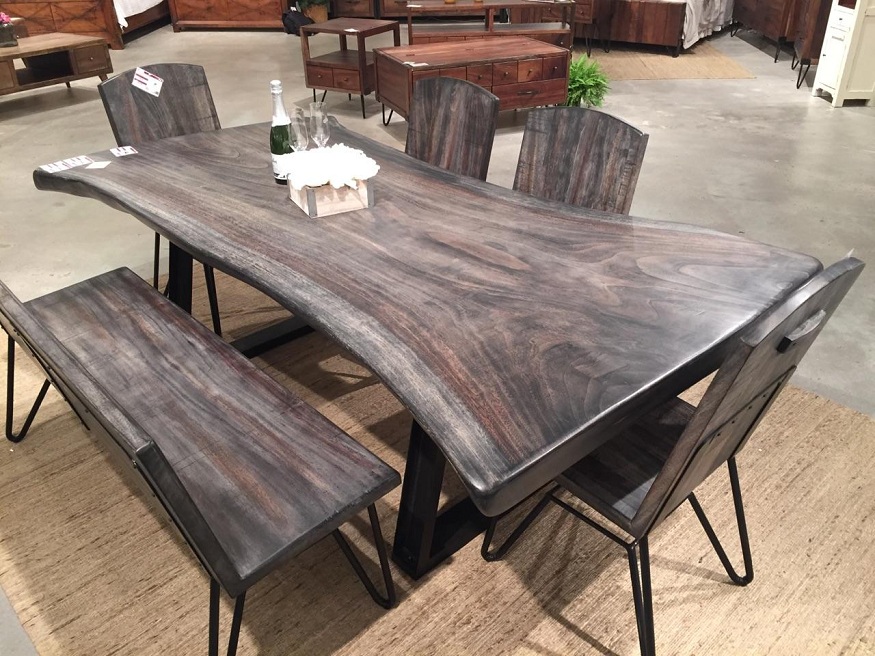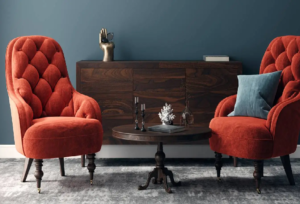Imagine a piece of furniture that transcends ordinary design, embodies the raw essence of nature, and brings an unparalleled sense of style to your home. That’s the magic of a live edge walnut table. Its charismatic aesthetic and rich, earthly charm make it a distinguished and captivating addition to any space.
Using natural, unprocessed wood edges to create furniture, such as the custom kitchen table, gives each piece an individual identity, simultaneously infusing a touch of nature into our living environments. The popularity of live-edge furniture, particularly walnut tables, is a growing trend that homeowners and interior designers have come to embrace for its unparalleled allure and the sense of serenity it fosters.
In this blog post, we’ll journey into the heart of this trend, exploring the beauty, history, and characteristics that make live-edge walnut tables a captivating centerpiece in our homes.
The History of Live-edge Furniture
The beauty of live-edge furniture has been appreciated for centuries. Still, George Nakashima, an influential American architect and furniture designer, brought it to mainstream design during the mid-20th century. A dedicated believer in the philosophy that every tree has a distinct life and story, Nakashima emphasized retaining the original contour of the tree in his designs.
His innovative approach of incorporating the live edge, the natural, raw edge of the wood, in furniture design has inspired countless artisans. This unique design philosophy shifted the course of furniture design, propelling live-edge furniture from a niche trend to a cherished staple in many homes and spaces.
Today, a custom dining table with a live edge, especially made from walnut, signifies an enduring commitment to preserving and appreciating the beauty of nature.
Characteristics of Walnut Wood
Chosen for its rich, warm tones, walnut wood exudes a natural elegance that is hard to overlook. Its colors range from deep chocolate brown to lighter, honeyed hues, all accentuated by its stunning, straight grain. But walnut’s appeal extends beyond its striking aesthetics.
Known for its durability and resistance to decay, walnut stands up to time and use, making it an ideal choice for a centerpiece like the live edge kitchen table. Additionally, the sustainability factor adds to its allure. Walnut trees grow in abundance in North America. They are harvested in a controlled manner, making them a renewable, eco-friendly resource.
These factors combined make walnut wood the material for crafting exquisite live-edge furniture.
The Live-edge Design Process
Creating a live-edge walnut table is an artistic endeavor that respects and highlights the natural form of the wood. It begins with careful selection, choosing a slab of walnut that has the desired thickness and size and features an interesting edge, grain, and unique characteristics like knots and burls.
The natural edge is then preserved, maintaining the wood’s original form. Skilled artisans employ various techniques such as sanding, oiling, and finishing to enhance the beauty of the wood, thereby bringing the live-edge walnut table to life.
Every step of the process is mindful of honoring the tree’s unique story, culminating in a piece of furniture that serves as a testament to the tree’s life.
Unique Features of Live-edge Walnut Tables
Live-edge walnut tables are not just pieces of furniture; they are unique works of art. Each table tells a different story, showcasing the distinct personality of the tree from which it was crafted.
With its raw and unprocessed charm, the live edge captures the wood’s unique grain patterns, knots, and burls, creating a tactile and visual delight. Whether it’s the spiraling grain, the intriguing knot, or the complex burl, these characteristics add depth and interest to the table, rendering each piece an original.
These one-of-a-kind features form the crux of the live-edge design philosophy, breathing life into the walnut table and making it an embodiment of natural beauty.
Customization Options
One of the many advantages of live-edge walnut tables is their vast array of customization options. Whether determining the size and shape of the table to fit a specific space or selecting a finish that complements your interior design, the options are virtually limitless.
You can leave the wood in its natural state or opt for a finish that enhances its color. Artisans may also offer the option to incorporate additional materials into the design, such as metal legs for a rustic-industrial look or a glass section to showcase the live edge.
The adaptability of live-edge tables extends to various uses, whether as live-edge kitchen tables that add character to your cooking space or custom dining tables that bring warmth and organic charm to your meals.
The Role of Live-edge Walnut Tables in Interior Design
Live-edge walnut tables offer a unique opportunity to bridge the gap between the natural world and our interior spaces. These tables are versatile design elements that complement various styles, whether adding a rustic charm to a farmhouse-style home or infusing a touch of nature into a modern, minimalist space.
They serve as focal points, drawing the eye and setting the room’s tone. But they’re not just visually striking; they also add a tactile element to the interior design. The texture of the live edge and the natural grain of the walnut wood invite touch, fostering a deeper connection with the natural world.
Furthermore, the versatility of live-edge tables is further enhanced when paired with different materials and color palettes, ensuring they fit perfectly into any design scheme.
Caring for Your Live-edge Walnut Table
Proper care and maintenance are essential to keeping your live-edge walnut table looking its best. Regular cleaning using a soft cloth and mild, non-abrasive soap can help preserve its natural beauty.
Avoid using harsh chemicals or abrasive materials, which can damage the wood’s surface. To prevent scratches or damage, using coasters or placemats is a good idea. Regularly applying a suitable oil can also help nourish the wood and maintain its luster.
Protecting your table from extreme temperatures and humidity is essential, which can cause the wood to crack or warp. With these precautions, your live-edge walnut table can remain a stunning centerpiece for years.
The Investment Value of Live-edge Walnut Tables
Live-edge walnut tables are more than just pieces of furniture; they are an investment. With each piece’s unique and growing appreciation for artisanal craftsmanship, live-edge walnut tables can retain or increase their value over time.
The intrinsic value lies not just in the material but in the story that the piece tells, the craftsmanship it showcases, and the timeless design it carries. In addition, as sustainability becomes a more significant factor in consumer choices, the use of responsibly sourced walnut wood adds to the appeal of these tables.
By choosing a live-edge walnut table, you’re not just choosing a piece of furniture, but a conversation piece, an artwork, and a testament to your commitment to sustainability.
Conclusion:
The live-edge walnut table uniquely blends nature’s beauty and human craftsmanship. Its rich hues, unique features, and history create a piece that is as much a conversation starter as a functional furniture piece. The ability to customize these tables ensures that they can fit into any space and reflect personal style.




